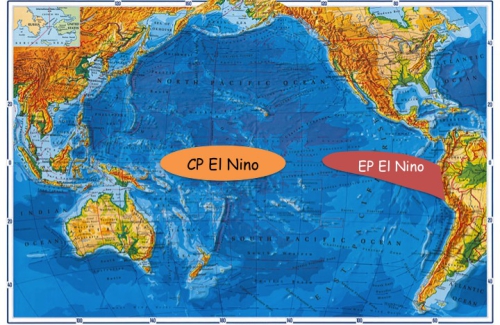Scientists Find Why CP El Nino Harder to Predict than EP El Nino
Date:2017-11-22
El Ni?o–Southern Oscillation (ENSO), which is one of the most striking interannual variabilities in the tropical Pacific, has been extensively studied for several decades. Understanding the changes in its characteristics is still an important issue in environmental and socioeconomic spheres worldwide. Recently, a new type of El Ni?o [central Pacific (CP) El Ni?o] has emerged, in which maximum sea surface temperature (SST) anomalies are confined mostly to the CP—different to the canonical type [eastern Pacific (EP) El Ni?o], in which the maximum SST anomalies are located in the eastern Pacific. The more frequent occurrence of CP El Ni?o and its different impacts on global climate compared to EP El Ni?o have been well documented. However, a systematic examination of the performance of climate models in predicting the two types of El Ni?o had yet to be undertaken, and it remained controversial as to whether the predictability differs among state-of-the-art climate models.
Prof. ZHENG Fei from the Institute of Atmospheric Physics, Chinese Academy of Sciences and Prof. Jin-Yi YU, from the University of California, Irvine, explored the performance of the IAP’s ENSO ensemble prediction system with respect to the two types of El Ni?o, focusing on the nine EP El Ni?o and twelve CP El Ni?o events that have occurred since 1950.

In addition to the eastern Pacific El Ni?o which we have been quite familiar with, a second El Ni?o in the central Pacific has emerged. (Image by ZHENG Fei)
"We found that the skill scores for EP events were significantly better than those for CP events at all lead times," says ZHENG, “the possible reasons are related to the systematic forecast biases coming mostly from the prediction of CP events; and systematic error characterized by an overly warm eastern Pacific during the spring season, indicating a stronger spring prediction barrier for CP El Ni?o."
Further improvements to coupled atmosphere–ocean models in terms of CP El Ni?o prediction should be recognized as a key and high-priority task for the climate prediction community. The study was recently published in Advanced in Atmospheric Sciences.
Reference:
Zheng, F., and J.-Y. Yu, 2017: Contrasting the skills and biases of deterministic predictions for the two types of El Ni?o. Adv. Atmos. Sci., 34(12), doi: https://doi.org/10.1007/s00376-017-6324-y.
Media Contact:
Ms. LIN Zheng, jennylin@mail.iap.ac.cn
